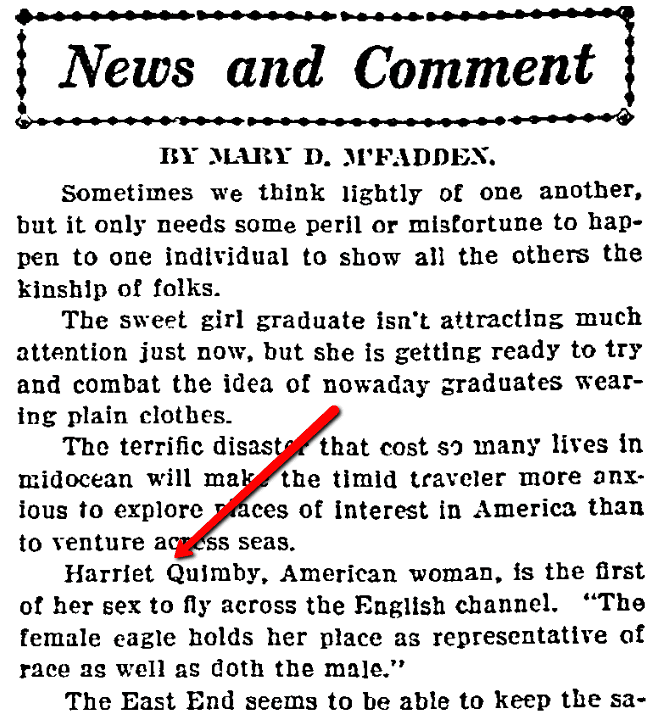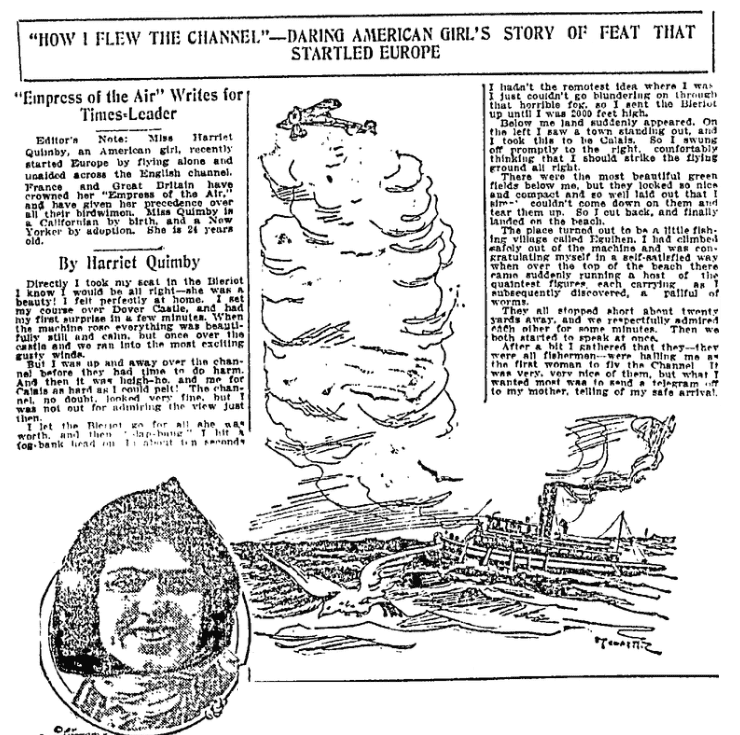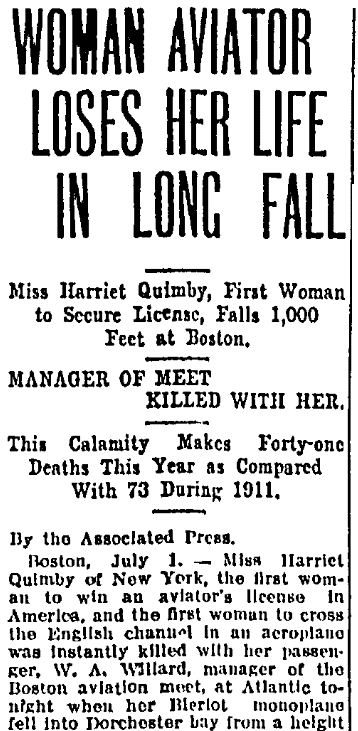When people think of American women pioneers in aviation, Amelia Earhart usually comes to mind. However, Harriet Quimby was the first woman to earn a pilot’s license in the United States, which she accomplished on 1 August 1911 – 12 years before Earhart.

In September of that year, Quimby achieved another distinction: the first woman to make a nighttime flight. Then, on 16 April 1912, she performed a remarkably brave and daring feat: the first woman to fly across the English Channel, which she accomplished in 59 minutes flying solo in a 50-horsepower monoplane!
She had made history, but received little of the acclaim Earhart received years later in much more powerful and advanced airplanes, such as Earhart’s 1932 transatlantic solo flight, or when she flew from Hawaii to California in 1935. The reason? The day before Quimby’s historic flight the Titanic sank, which dominated the news for weeks afterward.

Just 11 months after receiving her pilot’s license, as her flight career and fame were beginning to really take off, Quimby’s life tragically ended in a fatal airplane accident – just as Earhart’s would 25 years later. However, unlike Earhart’s mysterious disappearance, Quimby’s death occurred in full view of a horrified audience.
On 1 July 1912, Quimby was performing in the Third Annual Boston Aviation Meet, held in Squantum, Massachusetts. She made a flight around Dorchester Bay, carrying William Willard, the air show’s organizer, as a passenger. As her plane was returning, with a crowd of 5,000 spectators watching her every move, her plane suddenly pitched forward at an altitude of 1500 feet. Both she and Willard tumbled out of their seats – they were not wearing seat belts – and hurtled through the air to their deaths, plunging through shallow water into the bay’s mud just 20 feet from the shoreline. She was 37 years old.
The following short notice, two sentences buried in a “News and Comment” column, is typical of how little attention the press paid to Quimby’s amazing flight across the English Channel.

Here is a transcription of this article:
Harriet Quimby, American woman, is the first of her sex to fly across the English Channel. “The female eagle holds her place as representative of race as well as doth the male.”
The Philadelphia Inquirer also gave her feat two sentences.

Here is a transcription of this article:
Miss Harriet Quimby is the first woman to cross the English Channel driving her own aeroplane. And yet some persons say that women don’t have the requisite amount of nerve to turn these little tricks!
Finally, nearly two months after her historic flight and after the news of the Titanic had died down, this newspaper hired Quimby to write a short account of her daring flight.

Here is a transcription of this article:
“HOW I FLEW THE CHANNEL” – DARING AMERICAN GIRL’S STORY OF FEAT THAT STARTLED EUROPE
“Empress of the Air: Writes for Times-Leader
Editor’s Note: Miss Harriet Quimby, an American girl, recently startled Europe by flying alone and unaided across the English Channel. France and Great Britain have crowned her “Empress of the Air,” and have given her precedence over all their birdwomen. Miss Quimby is a Californian [correction: Michigan – ed.] by birth, and New Yorker by adoption. She is 24 years old.
By Harriet Quimby
Directly I took my seat in the Bleriot I knew I would be all right – she was a beauty! I felt perfectly at home. I set my course over Dover Castle, and had my first surprise in a few minutes. When the machine rose everything was beautifully still and calm, but once over the castle and [I] ran into the most exciting gusty winds.
But I was up and away over the Channel before they had time to do harm. And then it was heigh-ho, and me for Calais as hard as I could pelt! The Channel, no doubt, looked very fine, but I was not out for admiring the view just then.
I let the Bleriot go for all she was worth, and then “slap-bang” I hit a fogbank head on. In about ten seconds I hadn’t the remotest idea where I was. I just couldn’t go blundering on through that horrible fog, so I sent the Bleriot up until I was 2000 feet high.
Below me land suddenly appeared. On the left I saw a town standing out, and I took this to be Calais. So I swung off promptly to the right, comfortably thinking that I should strike the flying ground all right.
There were the most beautiful green fields below me, but they looked so nice and compact and so well laid out that I simply couldn’t come down on them and tear them up. So I cut back, and finally landed on the beach.
The place turned out to be a little fishing village called Equihen. I had climbed safely out of the machine and was congratulating myself in a self-satisfied way when over the top of the beach there came suddenly running a host of the quaintest figures, each carrying, as I subsequently discovered, a pailful of worms.
They all stopped short about twenty yards away, and we respectfully admired each other for some minutes. Then we both started to speak at once.
After a bit I gathered that they—they were all fishermen—were hailing me as the first woman to fly the Channel. It was very, very nice of them, but what I wanted most was to send a telegram off to my mother, telling of my safe arrival.
Her fatal accident received more press coverage than her flying feats, such as this article from the Aberdeen American. This article reports that Quimby and Willard were “instantly killed” – which is no doubt true of their impact when they landed. But one shudders to think of the long, terrifying moments when they hurtled through the air to their deaths…

Here is a transcription of this article:
WOMAN AVIATOR LOSES HER LIFE IN LONG FALL
Miss Harriet Quimby, First Woman to Secure License, Falls 1,000 Feet at Boston.
Manager of Meet Killed with Her.
This Calamity Makes Forty-one Deaths This Year as Compared with 73 during 1911.
By the Associated Press.
Boston, July 1. – Miss Harriet Quimby of New York, the first woman to win an aviator’s license in America, and the first woman to cross the English Channel in an aeroplane, was instantly killed with her passenger, W. A. Willard, manager of the Boston aviation meet, at Atlantic tonight when her Bleriot monoplane fell into Dorchester Bay from a height of a thousand feet.
The accident happened when Miss Quimby and Willard were returning from a trip over Boston Harbor to Boston Light, a distance of twenty miles in all. The flight was made in twenty minutes. The Bleriot, one of the latest models of military monoplanes, circled the aviation field and soared out over the Savinhall Yacht club just outside the aviation grounds.
Heading back into an eight-mile [per hour] gusty wind, Miss Quimby started to volplane [dive at a steep angle]. The angle was too sharp and one of the gusts caught the tail of the monoplane, throwing the machine up perpendicular.
For an instant it poised there. Then, sharply outlined against the setting sun, Willard was thrown clear of the chassis, followed almost immediately by Miss Quimby. Hurtling over and over the two figures shot downward, striking the water twenty feet from the shore. The bodies were badly crushed.
Machine Drops After.
They splashed out of sight a second before the monoplane plunged down fifteen feet away.
It was low tide and the water was only five feet deep. Men from the yacht club, in motor boats, were on the spot quickly and, leaping overboard, dragged the bodies out of the surf. Death probably was instantaneous.
An examination of an aeroid [sic] barometer after the fall showed that at times the daring pilot had reached the height of 5,000 feet. On its return the machine was seen to wobble in the gusty breeze.
The setting of the last accident of the last disaster could not have been more dramatic. It was sunset. Great white wings swept directly into the west and dipped toward the earth. There was an upward flash of the tail, and outlined before the spectators in the red light of the west, the figures were seen to shoot from their seats into the bay 1,000 feet below.
Fourth Woman to Die.
Miss Quimby is the fourth woman to lose her life in an aeroplane accident. The first woman killed was Madame Denise Moore, who fell while flying in France in July 1911. Susanne Bernard, another French woman, was killed last March while making tests for an aviator’s license. Miss Julia Clark, a Chicago girl, was the third victim. She was killed when she flew into a tree at Springfield, Ill., on June 15.
W. A. P. Willard, manager of the Boston meet, who was killed while riding with Miss Quimby, was the father of Charles Foster Willard, the well known aviator.
The death of Miss Quimby and Willard brings the total of the aviation fatalities for the present year up to 41, compared with 73 during all of 1911.
Related Articles:
